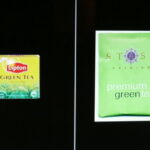There are several different flavors to choose from in both Lipton and Nestea iced teas. The main experience I have with both products is the green tea with citrus in Lipton’s product and the green tea with lemon in Nestea, not much difference. Both products are rich in protective flavonoid anti-oxidants. They both come in convenient plastic bottles, usually 16.9 ounces. Lipton and Nestea both have diet versions of their product sweetened by aspertame. The biggest difference I find in the products is taste. More on that, later.
Tea is roughly 5,000 years old, making tea the worlds’ second oldest beverage, behind only water. It is believed to have been discovered in China in 2737 B.C. by Chinese Emperor Shen Nung. Of course I’m sure ancient China had pundits saying that Nung exaggerated his role in the discovery. Not that any Emperor pr politician would ever do such a thing.
Iced tea was unveiled at the World’s Fair in 1904 in St. Louis, MO by a man named Richard Blechynden. Because of a heat wave, and St Louis can get very hot in the summer, no one wanted to try Blechynden’s hot tea, so he dumped ice in it and voila!
The anti-oxidants found in tea can help the body protect itself against “free radicals”, no not Jane Fonda or Abbie Hoffman, but molecules that can damage cells. Anti-oxidants called flavonoids can do that.
Chronic damage by free radicals is thought to contribute to the development of many chronic diseases, including heart disease and cancer. The average cup of brewed tea, green or black, has from 150-200 miligrams of flavonoids. Flavonoids help immune response by acting as anti-allergies, anti-inflammatory, anti-viral., and anti-bacterial agents. They can’t do the work of viagra or cialis, but in the case of the “four hour erection”, that might not be such a bad thing.
Studies show that Americans consume 20% of their caloric intake from drinks, twice what we need, so I recommend the diet version of the Lipton product. There are several different flavors, White Raspberry, Peach, Mixed Berry, and my personal favorite, the Green Tea with Citrus. All of these products are available in regular or diet, with the diet version sweetened by aspertame. Why Lipton? Mainly the taste. I have tried both brands, and just found the Lipton to taste much better.
Neither product contains any trans fat, saturated fat, no significant source fo any fats, but neither contains any protein either. It should be noted that both brands, Lipton and Nestea, have high fructose corn syrup in the regular flavor, another reason to prefer the diet version. There are 47 grams of sugar in the Nestea regular flavor, and I have noticed that their diet flavor can be hard to find. The Lipton brand usually has both versions right next to one another on the store shelves. Most of the bigger chains carry the Lipton since it was introduced a couple of years ago.
In keeping with the health conscious trend that exists in our society, the idea of cutting back on sodas and coffee seems to be a good one, and one way to start is to drink more tea. Green tea, especially has it’s health benefits, the anti-oxidants and all. As for those who don’t like the taste of diet drinks, there does not seem to be a big difference in the regular and diet versions of Lipton. I can hardly tell any difference, and as long as lab rats don’t keel over dead from aspertame, it seems like a good idea to continue this policy.






